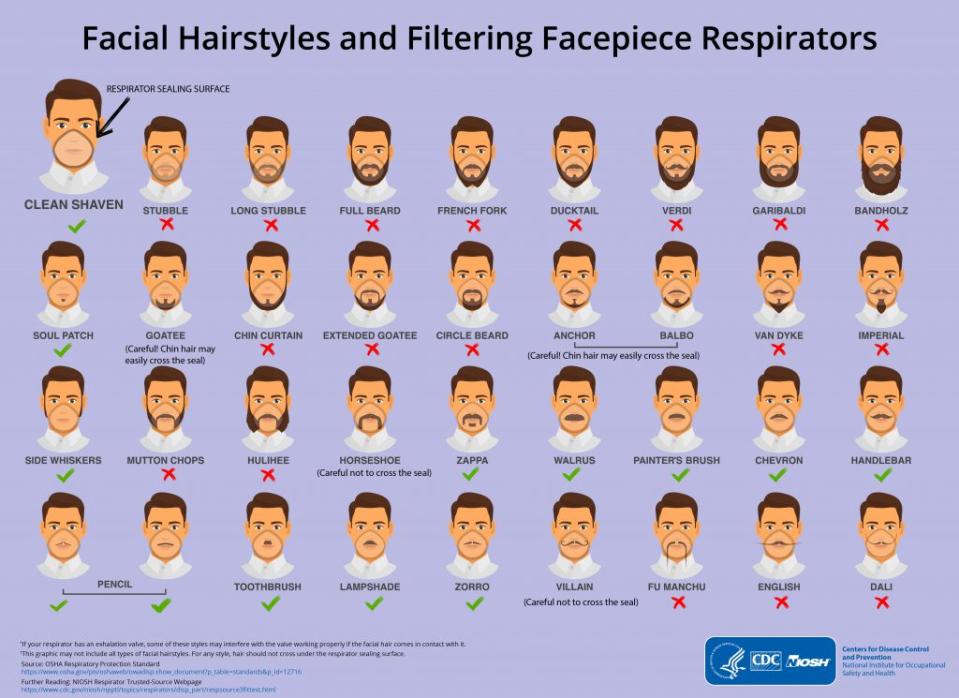CDC guidelines on male facial hair goes viral amid the coronavirus fears
Coinciding with the Centers for Disease Control (CDC) warning Americans to prepare for the spread of the coronavirus (COVID-19) — with “the expectation that this could be bad” — a 2017 infographic with facial hair guidelines for those who wear respirators at work is getting noticed on social media.
The CDC infographic — created nearly three years before the outbreak but going viral just this week — was created in honor of observances including “No Shave November” and “Movember,” which encourage men to grow beards for cancer awareness. And now the guide, appropriate or not, has been seized by social media in relation to the coronavirus.
Referring to the no-shave observances, a CDC blog post for the infographic notes, “These increasingly popular campaigns are a great way to demonstrate your support… unless you need to wear a tight-fitting respirator for your job,” “Don’t despair! We will not completely ruin your plans to compete for facial hair bragging rights. But we’re going to have to get creative about it…”
The infographic suggests facial-hair options that won’t interfere with respirator effectiveness — with styles including the soul patch, side whiskers, pencil and lampshade as being approved, although a clean-shaven face is ideal. Meanwhile, sporting stubble, an extended goatee, chin curtain, mutton chops, and full beard are all risky choices
The CDC explains that facial hair growing in areas covered by a respirator seal won’t allow a proper fit. In fact, “Facial hair is a common reason that someone cannot be fit tested.”

“The reason for this is simple – gases, vapors, and particles in the air will take the path of least resistance and bypass the part of the respirator that captures or filters hazards out,” reads the CDC blog post. “So then, why can’t facial hair act as a crude filter to capture particles that pass between the respirator sealing area and the skin? While human hair appears to be very thin to the naked eye, hair is much larger in size than the particles inhaled. Facial hair is just not dense enough and the individual hairs are too large to capture particles like an air filter does; nor will a beard trap gases and vapors like the carbon bed in a respirator cartridge.
“Therefore, the vast majority of particles, gases, and vapors follow the air stream right through the facial hair and into respiratory tract of the wearer,” it continues. “In fact, some studies have shown that even a day or two of stubble can begin to reduce protection. Research tells us that the presence of facial hair under the sealing surface causes 20 to 1000 times more leakage compared to clean-shaven individuals.”
Michelle Barron, MD, medical director of infection prevention and control at UCHealth University of Colorado Hospital, clarifies to Yahoo Lifestyle why the guide might not exactly be relevant to the general public in preparing for coronavirus outbreaks: “These CDC guidelines apply to healthcare workers who wear respirators — not the standard masks for the public at large.”
Facial or surgical masks with elastic bands that wrap around the head are given to sick people who risk infecting others. “The mask captures droplets from the mouth and helps contain the illness,” says Barron. “That’s why we tell people with the flu to wear them.”
However, respirators, such as the N95, are typically worn by healthcare workers, including infectious disease physicians, nurses, or respiratory therapists. They filter air and protect outside germs from coming inside the mask.
“With respirators, we account for facial shape and hair,” says Barron. “If someone grows a beard or fluctuates in weight, the gear won’t sit close enough to the skin and need re-fitting.”
The CDC says that face masks aren’t recommended for healthy people. “You should only wear a mask if a healthcare professional recommends it,” reads the website. “A face mask should be used by people who have COVID-19 and are showing symptoms. This is to protect others from the risk of getting infected. The use of face masks also is crucial for health workers and other people who are taking care of someone infected with COVID-19 in close settings (at home or in a health care facility).”
Respirators are also not recommended, says the CDC, “outside of workplace settings (in the community).”
Those warnings have not stopped the demand for masks, including those falsely marketed to treat the coronavirus. It’s why the Better Business Bureau (BBB) issued a “Scam Alert,” reading, “Unfortunately, phony online stores abound — especially when an item is in high demand. Some sites may take your money and send you low-quality or counterfeit masks. Others may never deliver anything all. In the worst cases, these sites are actually a way to steal your personal and credit card information, opening you up to identity theft.”
According to the CDC, fever, cough or shortness of breath are coronavirus symptoms which can appear anywhere from two to 14 days after exposure. There is no vaccine or specific treatment for the coronavirus, so the CDC recommends avoiding exposure — wash hands regularly, disinfect surfaces with common cleaning products, and avoid touching your mouth, eyes and ears.
Read more from Yahoo Lifestyle:
Want daily pop culture news delivered to your inbox? Sign up here for Yahoo Entertainment & Lifestyle's newsletter.



